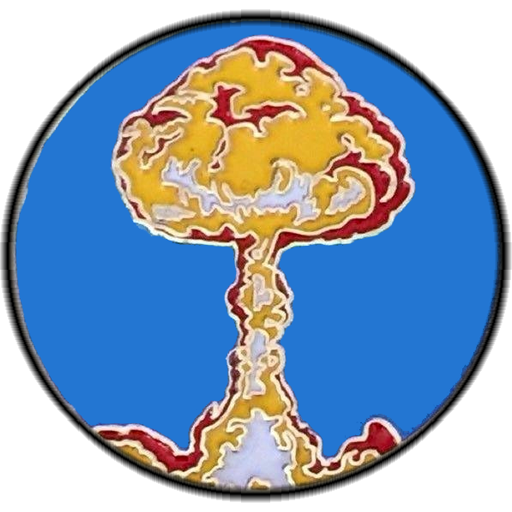Mk3
| Designer |
| Los Alamos (1943-1947) |
| Type |
| Implosion |
| Dimension(s) |
| 128″ x ~60″ |
| Weight(s) |
| 10,450lbs |
| Yield(s) |
| ~23-26Kt |
| Application(s) |
| (BOMB) F-31 “Fat Man” |
| (BOMB) Mk3 |
| (BOMB) Mk3A |
| (BOMB) Mk3 Mod 2 |
| Tests |
| Operation Crossroads, shot Able #2( 1946/06/30 )3.1 Effects test of the stockpiled Mk3A “Christy” device. 21Kt.10.1 |
| Operation Crossroads, shot Baker #3( 1946/07/24 )3.1 Effects test of the stockpiled Mk3A “Christy” device. 21Kt. 10.1 |
The Mk3 “Fat Man” bomb, model number 1561 was dropped on the Japanese city of Nagasaki on August 9th 1945. It is a High Explosive (HE) device using a Type A pit.1.1 The concept of an implosion-device was pioneered by Robert F. Christy of Los Alamos Theoretical Division.3.1
5,300lbs of Composition B and Baratol high explosives were used.15.1
Model 1222 had twelve pentagonal sections of Dural bolted together to form a sphere, and surrounded by an armor steel shell of icosahedral structure, with stabilizing shell attached. Assembly of this model took around 1500 bolts8.1
Mid-summer of 1944 the Model 1561 was developed, which included a spherical shell made of two polar caps and five equatorial zone segments. The sphere was then enveloped by an ellipsoidal shell of armor attached at the equator.8.2
USAAF Captain David Semple suggested adding angular drag-plates into the box tail of the bomb to increase drag, resulting in a stable model.8.1
Total device weight was approximately 10,000 lbs. It achieved a nominal yield of 23±3 kt using the URCHIN initiator1.2
Weapon was 10,900lbs, 60″ in diameter7.1 and 128″ long.4.1
X-Unit was charged to 5600 volts before the weapon was released from the plane5.1
By the end of 1947 composite, plutonium and uranium, cores were stockpiled for use with the Mk312.1
May 1948, Mk3 weapons had been referred to as “FM 1561”6.1
Post-war “Fat Man” type bombs are referred to as MK3A, Christy Devices, or Model 1561 Devices9.1
1949, Mk3 Mod 1 being brought into the stockpile.11.1
Mk3 Mod 213.1
Critical components for the post-wary Mk3A were in short supply, such as HE castings and initiators, which became available around April 194712.1
By the end of Jun 1947 there were 9 FM 1561s and 4 Mk3s.12.1
Mk3 weapon shapes for ballistic testing were called M107 Training Units14.1
The pumpkin spheres were assembled and filled by Project Camel, at Inyokern, and usually were shipped by rail or flown to W-47 with the ballistic case and tail attached.16.2
The Y-1222 “Fat Man” design was abandoned in late summer of 1944, the Y-1561 “Fat Man” system in its ballistic case, as well as the L-2B “Little Boy” design commenced drop testing in October 1944.16.1
During drop testing, a number of issues arose that affected the accuracy of the weapon, after some investigation into the issue the technicians found that the suspension lug of the ballistic case was not releasing properly causing inaccuracies and also the sharp edges of the box tail would scrape against the vertical guide rails in the bomb bay. To correct the issue with the suspension system a recess was cut in the bottom surface of the suspension lug and the original steel was replaced with a piece of highly polished beryllium-copper alloy.16.1
















References
- Hansen, C. (1995). Swords of Armageddon: The Development of U.S. Nuclear Weapons—Arming, Fuzing, Safing, and Appendices (2nd Edition, Vol. 7). Chukelea Publications. http://www.worldcat.org/oclc/62490342
- Table A-1, p.96
- Defense Atomic Support Agency. (1962). Nuclear Test Summary Trinity through Hardtack (DASA-1220). https://pdfslide.net/documents/nuclear-testing-summary-from-trinity-to-hardtack.html
- p.34
- Ogle, W. E. (1985). An Account of the Return to Nuclear Weapons Testing by the US After the Test moratorium 1958-1961. https://www.osti.gov/opennet/servlets/purl/16156584.pdf
- p.31
- p.85
- Sandia National Laboratory Information Research Division 3434. (1967). History of the Mark 5 Bomb (RS 3434/2). https://osf.io/46sfd/
- p.6
- Sandia National Laboratory Information Research Division 3434. (1967). History of the Mark 4 Bomb (RS 3434/1). https://osf.io/46sfd/
- p.14
- Defense Atomic Support Agency. (1959). First History of AFSWP 1947-1954: Volume 1, 1947-1948: Chapter 5—Sandia Base (Vol. 1). Armed Forces Special Weapons Project. https://ntrl.ntis.gov/NTRL/dashboard/searchResults/titleDetail/PB99143653.xhtml
- p.79
- Johnson, L. (1997). Sandia National Laboratory: A History of Exceptional Service in the National interest (No. SAND97-1029; p. 442). Sandia National Laboratories. http://large.stanford.edu/courses/2018/ph241/blair1/docs/sand-97-1029.pdf
- p.36
- Hawkings, D., Truslow, E. C., & Smith, R. C. (1961). Manhattan District History Project Y The Los Alamos Project; Volume 1—Inception Until August 1945 & Volume 2—August 1945 Through December 1946 (LAMS-2532). https://www.osti.gov/opennet/manhattan-project-history/publications/LANLMDHProjectYPart1.pdf
- p.146
- p.147
- Norris, R. S., & Cochran, T. B. (1994). United States Nuclear Tests July 1945 to 31 December 1992. (NWD 94-1) https://fas.org/nuke/cochran/nuc_02019401a_121.pdf
- p.22
- U.S. Department of Energy: National Nuclear Security Administration Nevada Field Office. (2015). United States Nuclear Tests July 1945 through September 1992 (DOE/NV–209-REV 16). https://www.osti.gov/servlets/purl/1351809
- p.2
- Sandia Base Headquarters. (1949). Sandia Base History: 01 July 1948—01 January 1949. https://ntrl.ntis.gov/NTRL/dashboard/searchResults/titleDetail/PB99143760.xhtml
- p.36
- The Bulletin of the Atomic Scientists. (1985). Bulletin of the Atomic Scientists; 1985—Vol 41. Bulletin of the Atomic Scientists, 41(1–11), 755. https://www.tandfonline.com/toc/rbul20/41/1?nav=tocList
- p.449 (PDF Page)
- MkIV Evaluation Committee, Hoffman, J. A., Ayers, A. N., Bice, R. A., Dawson, J. J., Hopkins, L. A., Robinson, C. F., Runyan, C. E., Schreiber, R. E., Schulz, L. W., & Smith, L. D. (1949). Mk IV Mod 0 FM Bomb (p. 111) [Final Evaluation Report]. Los Alamos National Laboratory; California Branch. https://osf.io/46sfd/
- p.97 (PDF Page)
- Alexander Jr., F. C. (1963). History of Sandia Corporation: Through Fiscal Year 1963 (p. 79). Sandia Corporation. https://ntrl.ntis.gov/
- p.28 (PDF Page)
- Sweeney, C. W., Antonucci, J. A., & Antonucci, M. K. (1997). War’s End: An Eyewitness Account of America’s Last Atomic Mission. Avon Books. https://archive.org/details/warsendeyewitnes00swee
- p.20 (PDF Page)
- Russ, H. W. (1984). Project Alberta: The Preparation of Atomic Bombs for Use in World War II. Exceptional Books, Ltd. http://www.worldcat.org/oclc/24429257
- p.22 (PDF Page)
- p.30 (PDF Page)
